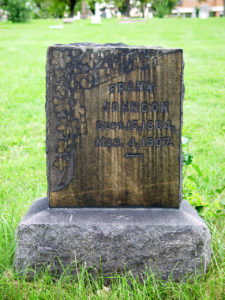Tales fromPioneers and Soldiers Memorial Cemetery
By Sue Hunter Weir
164th in a Series
In June 2002, Minneapolis Pioneers and Soldiers Cemetery was listed in the National Register of Historic Places. For 10 years or so it was the only cemetery in Minnesota designated as an individual landmark. The cemetery”'s built environment ”“ the fence, caretaker”'s cottage and flagpole ”“ made it eligible but so did the lives of the people who are buried there. Â
Their stories are a significant part of the city”'s social history. It is by no means the complete history of the city during its early years but tells the story of many thousands of the city”'s early residents including thousands of immigrants and their children.
In 1904, Sarah and Knut Nordeman, mother and son, entered into a suicide pact and overdosed on morphine. Knut survived but Sarah did not, and was buried in Pioneers and Soldiers Cemetery. Instead of a suicide note, the Nordemans left a signed a six-point explanation of their thinking that included some of their grievances.  One point in particular led to some soul-searching on the part of one of the city”'s major newspapers. The Nordemans, Swedish immigrants, believed that they had been discriminated against because of their “foreignness,” and that was what had prevented Knut from finding work that would enable him to support his mother.
This prompted the Minneapolis Tribune to run a story titled “Sought New Names: Foreign Names Confusing; Jawbreakers Have Been Simplified and Names of Embarrassing Associations Changed.” According to the story, the greatest number of people going to court to change their names were Scandinavians “”¦who got into trouble through the confusion of names which so frequently arises among that people.” The reasons that people gave for changing their names varied. Some changed their names in order to blend in by using a name that sounded more “American.” Others changed their names in order to stand out, to not be confused with others with the same or similar names. Â
Some confusion undoubtedly arose because so many people shared the same or similar last names. There are almost 1,000 Johnsons buried in the cemetery and that”'s not counting all of the variations (Johanson, Jonasson, Johnston, etc.). One of the city”'s early coroners, obviously unused to Norwegian accents, recorded a Norwegian woman”'s name as Wilmaney Sealotte Yonson, most likely his interpretation of Wilhemina Charlotte Johnson. And, there are slightly more than 800 Andersons, even more when you add in variable spellings. Those two names and their variations account for slightly less than 10% of the cemetery”'s burials.Â
First names may not yield as much information about immigration as last names but they provide an interesting social history of names as they have gone in and out of fashion. Some names ”“ Anna, Christine, John and William ”“ are names that were popular in 1900 and remain popular today. Other names have fallen out of fashion: we have a Zebedee, a Melethia, a Philander and a Sylbush. We have two Weatlhys, three Ulysses, 42 Myrtles and 49 Augustas. We don”'t have any Brittanys, Megans, Jasons or Troys.Â
The most common first name really wasn”'t really a name at all. There are 4,123 infants with no recorded first names of their own ”“ Babe Anderson, Babe Johnson, and so forth ”“ who account for almost 19% of the cemetery”'s 22,000 burials. Imagine.
Immigrants from Eastern European countries often changed their names to accommodate others who found their names unpronounceable. Jurag Hmelovsky from Slovakia became George Melowsky in America, a name that he used until he died. The correct spelling of his name is etched in granite on his headstone. Â
When it came to having a name with embarrassing associations Harry H. Hayward probably had a harder time of it that most. He shared first and last names with one of the state”'s most notorious criminals ”“ Harry T. Hayward. The fact that Harry H. had a different middle initial than Harry T. probably didn”'t prevent him from being mistaken for the mastermind of Minnesota”'s crime of the 19th century (who is buried in the cemetery). Harry H. remained in Minneapolis for four years after Harry T.”'s trial but ultimately changed his last name to Smith and moved to Chicago.Â
The city”'s social history is a fascinating one and is one that can be found, at least in part, in the cemetery”'s records. When the cemetery reopens in the spring stop in, and explore a part of the city”'s story. Â











